Domestic Violence and Child Abuse: Implications for Healthcare Workers
VerifiedAdded on 2023/06/13
|7
|2462
|216
AI Summary
This article discusses the legal and professional issues healthcare workers face when dealing with domestic violence and child abuse. It covers the different types of abuse, relevant legislation, and documentation requirements. The article also explores the implications for healthcare delivery and patient care.
Contribute Materials
Your contribution can guide someone’s learning journey. Share your
documents today.
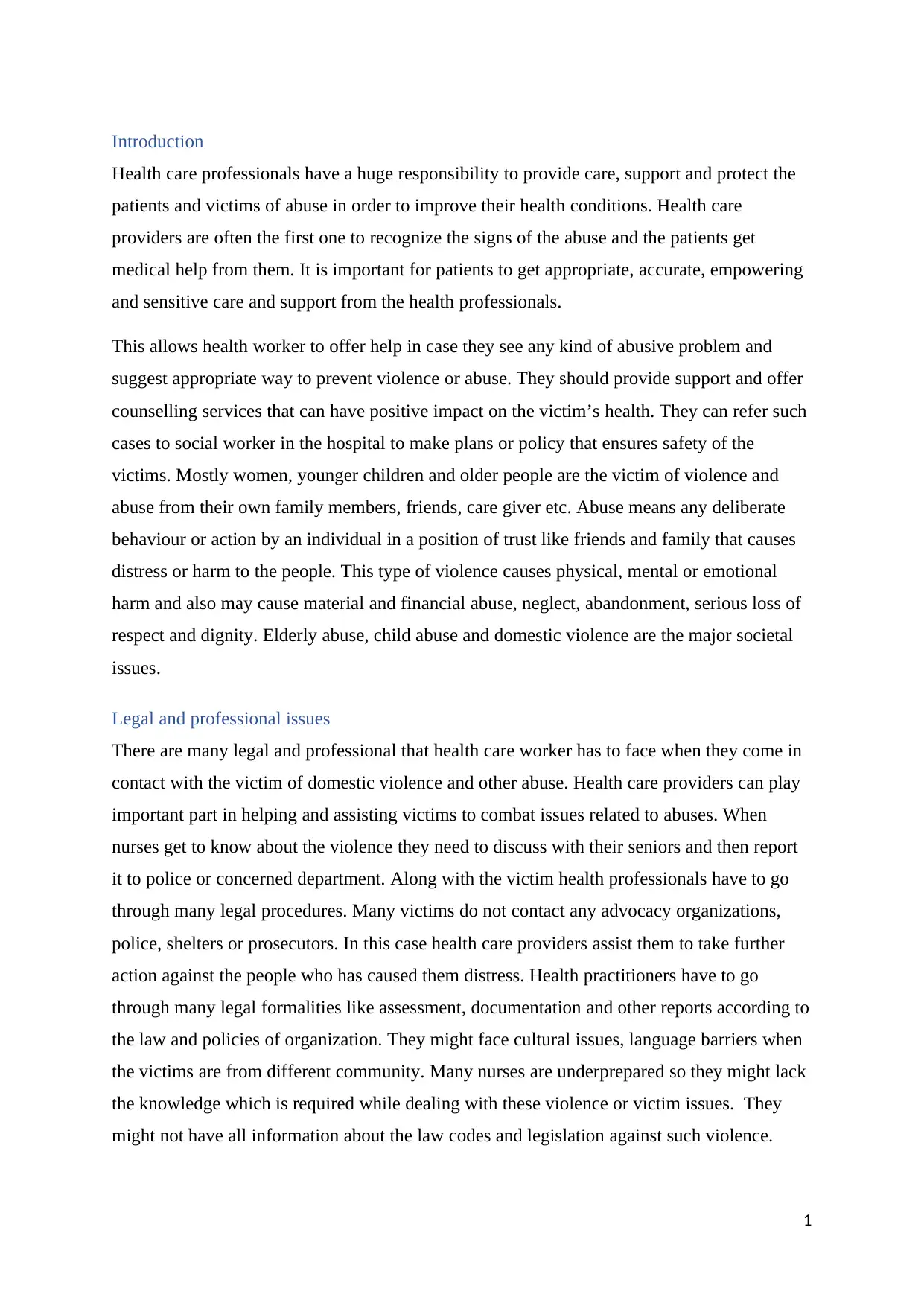
Introduction
Health care professionals have a huge responsibility to provide care, support and protect the
patients and victims of abuse in order to improve their health conditions. Health care
providers are often the first one to recognize the signs of the abuse and the patients get
medical help from them. It is important for patients to get appropriate, accurate, empowering
and sensitive care and support from the health professionals.
This allows health worker to offer help in case they see any kind of abusive problem and
suggest appropriate way to prevent violence or abuse. They should provide support and offer
counselling services that can have positive impact on the victim’s health. They can refer such
cases to social worker in the hospital to make plans or policy that ensures safety of the
victims. Mostly women, younger children and older people are the victim of violence and
abuse from their own family members, friends, care giver etc. Abuse means any deliberate
behaviour or action by an individual in a position of trust like friends and family that causes
distress or harm to the people. This type of violence causes physical, mental or emotional
harm and also may cause material and financial abuse, neglect, abandonment, serious loss of
respect and dignity. Elderly abuse, child abuse and domestic violence are the major societal
issues.
Legal and professional issues
There are many legal and professional that health care worker has to face when they come in
contact with the victim of domestic violence and other abuse. Health care providers can play
important part in helping and assisting victims to combat issues related to abuses. When
nurses get to know about the violence they need to discuss with their seniors and then report
it to police or concerned department. Along with the victim health professionals have to go
through many legal procedures. Many victims do not contact any advocacy organizations,
police, shelters or prosecutors. In this case health care providers assist them to take further
action against the people who has caused them distress. Health practitioners have to go
through many legal formalities like assessment, documentation and other reports according to
the law and policies of organization. They might face cultural issues, language barriers when
the victims are from different community. Many nurses are underprepared so they might lack
the knowledge which is required while dealing with these violence or victim issues. They
might not have all information about the law codes and legislation against such violence.
1
Health care professionals have a huge responsibility to provide care, support and protect the
patients and victims of abuse in order to improve their health conditions. Health care
providers are often the first one to recognize the signs of the abuse and the patients get
medical help from them. It is important for patients to get appropriate, accurate, empowering
and sensitive care and support from the health professionals.
This allows health worker to offer help in case they see any kind of abusive problem and
suggest appropriate way to prevent violence or abuse. They should provide support and offer
counselling services that can have positive impact on the victim’s health. They can refer such
cases to social worker in the hospital to make plans or policy that ensures safety of the
victims. Mostly women, younger children and older people are the victim of violence and
abuse from their own family members, friends, care giver etc. Abuse means any deliberate
behaviour or action by an individual in a position of trust like friends and family that causes
distress or harm to the people. This type of violence causes physical, mental or emotional
harm and also may cause material and financial abuse, neglect, abandonment, serious loss of
respect and dignity. Elderly abuse, child abuse and domestic violence are the major societal
issues.
Legal and professional issues
There are many legal and professional that health care worker has to face when they come in
contact with the victim of domestic violence and other abuse. Health care providers can play
important part in helping and assisting victims to combat issues related to abuses. When
nurses get to know about the violence they need to discuss with their seniors and then report
it to police or concerned department. Along with the victim health professionals have to go
through many legal procedures. Many victims do not contact any advocacy organizations,
police, shelters or prosecutors. In this case health care providers assist them to take further
action against the people who has caused them distress. Health practitioners have to go
through many legal formalities like assessment, documentation and other reports according to
the law and policies of organization. They might face cultural issues, language barriers when
the victims are from different community. Many nurses are underprepared so they might lack
the knowledge which is required while dealing with these violence or victim issues. They
might not have all information about the law codes and legislation against such violence.
1
Secure Best Marks with AI Grader
Need help grading? Try our AI Grader for instant feedback on your assignments.
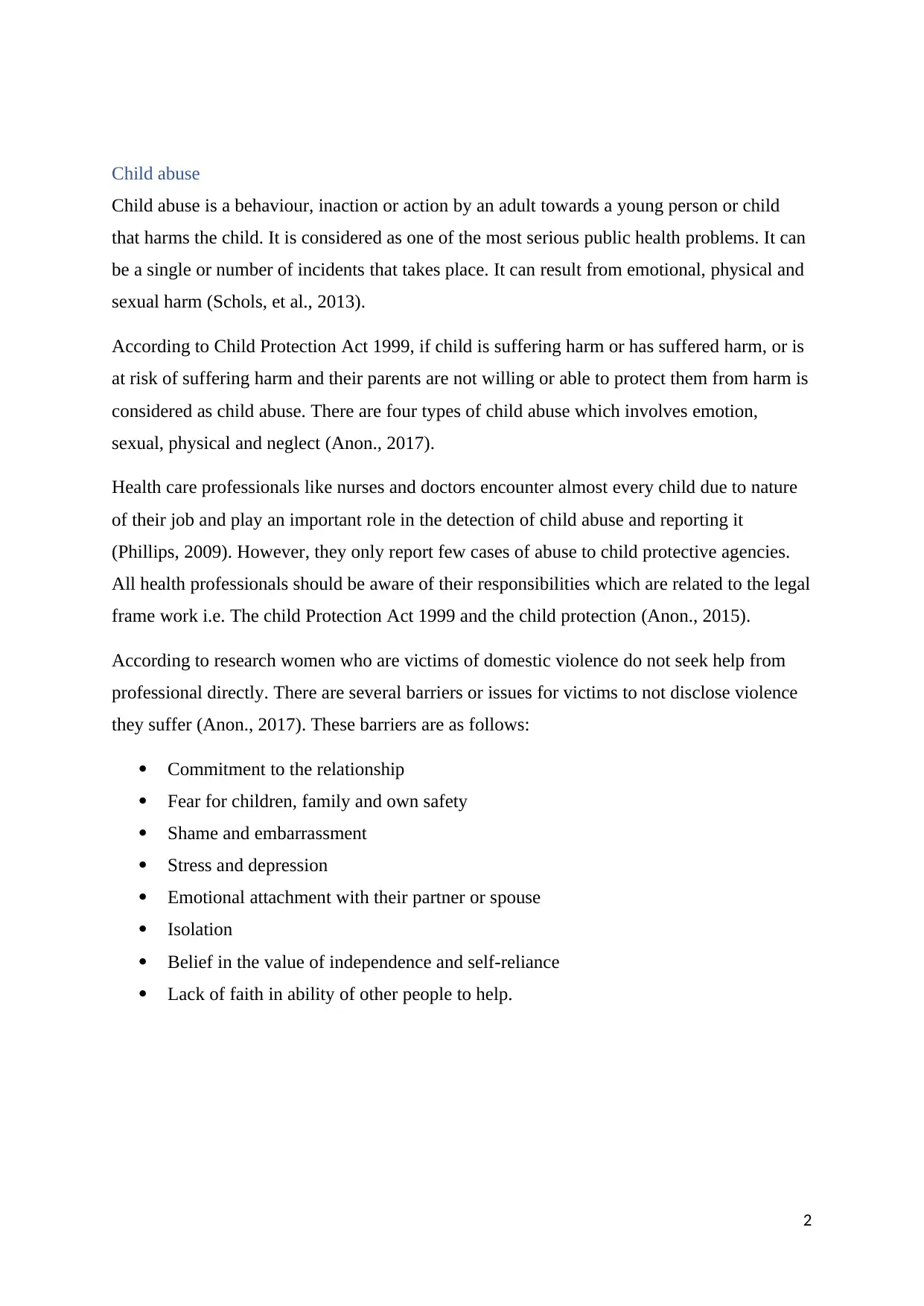
Child abuse
Child abuse is a behaviour, inaction or action by an adult towards a young person or child
that harms the child. It is considered as one of the most serious public health problems. It can
be a single or number of incidents that takes place. It can result from emotional, physical and
sexual harm (Schols, et al., 2013).
According to Child Protection Act 1999, if child is suffering harm or has suffered harm, or is
at risk of suffering harm and their parents are not willing or able to protect them from harm is
considered as child abuse. There are four types of child abuse which involves emotion,
sexual, physical and neglect (Anon., 2017).
Health care professionals like nurses and doctors encounter almost every child due to nature
of their job and play an important role in the detection of child abuse and reporting it
(Phillips, 2009). However, they only report few cases of abuse to child protective agencies.
All health professionals should be aware of their responsibilities which are related to the legal
frame work i.e. The child Protection Act 1999 and the child protection (Anon., 2015).
According to research women who are victims of domestic violence do not seek help from
professional directly. There are several barriers or issues for victims to not disclose violence
they suffer (Anon., 2017). These barriers are as follows:
Commitment to the relationship
Fear for children, family and own safety
Shame and embarrassment
Stress and depression
Emotional attachment with their partner or spouse
Isolation
Belief in the value of independence and self-reliance
Lack of faith in ability of other people to help.
2
Child abuse is a behaviour, inaction or action by an adult towards a young person or child
that harms the child. It is considered as one of the most serious public health problems. It can
be a single or number of incidents that takes place. It can result from emotional, physical and
sexual harm (Schols, et al., 2013).
According to Child Protection Act 1999, if child is suffering harm or has suffered harm, or is
at risk of suffering harm and their parents are not willing or able to protect them from harm is
considered as child abuse. There are four types of child abuse which involves emotion,
sexual, physical and neglect (Anon., 2017).
Health care professionals like nurses and doctors encounter almost every child due to nature
of their job and play an important role in the detection of child abuse and reporting it
(Phillips, 2009). However, they only report few cases of abuse to child protective agencies.
All health professionals should be aware of their responsibilities which are related to the legal
frame work i.e. The child Protection Act 1999 and the child protection (Anon., 2015).
According to research women who are victims of domestic violence do not seek help from
professional directly. There are several barriers or issues for victims to not disclose violence
they suffer (Anon., 2017). These barriers are as follows:
Commitment to the relationship
Fear for children, family and own safety
Shame and embarrassment
Stress and depression
Emotional attachment with their partner or spouse
Isolation
Belief in the value of independence and self-reliance
Lack of faith in ability of other people to help.
2

All health professions should have the information about the child protection and to report
against the suspected child abuse and neglect. They should have important knowledge about
the relevant legislation for child protection:
Child Protection Regulation (2011)
Child Protection Act (1999)
It provides the framework for the children protection in Queensland territory. Its main
principle is the safety, wellbeing of child.
Domestic violence
Any kind of abusive behaviour in a domestic setting like marriage by one individual against
another is known as domestic violence. According to the data released by Australian Bureau
of Statistics in 2017, 16% of Australian women are victims of domestic violence. It is
emerging as a significant issue nationally and internationally. Nurses being a group of health
workers considers domestic violence as a major health issue and play important role to assist
the victims (woman and their children) of domestic violence in their work in community
settings and hospitals. Domestic violence can cause many problems like psychological
trauma, depression substance use, disability, migraine headaches, suicidal tendency. It is also
called as Intimate Partner Violence and is a strictly punishable act in Australia. Nurses are
only allowed to disclose any information with consent of patient or when there is legal or
ethical obligation. It is important to use professional judgement while deciding to report such
issues. Nurses should consult with their supervisors or any experienced colleagues. In
Australia every state has particular public policies to deal with domestic violence.
The law related to family or domestic violence varies from state to state in Australia.
In Western Australia, the law related to domestic and family violence is the Restraining
orders act, 1977. There is a provision of both civil and criminal law to protect the victims of
domestic and family violence.
An order given by the court to ensure the safety of the victim by planning restriction on the
person whose action or behaviour can pose a threat or risk of future harm is known as
Restraining orders act. The type of condition imposed on the respondents may vary
depending upon circumstances and need of the victim including restriction on communicating
or making contacts, lawful vacation of a place or premises, prohibition on the use of fire
3
against the suspected child abuse and neglect. They should have important knowledge about
the relevant legislation for child protection:
Child Protection Regulation (2011)
Child Protection Act (1999)
It provides the framework for the children protection in Queensland territory. Its main
principle is the safety, wellbeing of child.
Domestic violence
Any kind of abusive behaviour in a domestic setting like marriage by one individual against
another is known as domestic violence. According to the data released by Australian Bureau
of Statistics in 2017, 16% of Australian women are victims of domestic violence. It is
emerging as a significant issue nationally and internationally. Nurses being a group of health
workers considers domestic violence as a major health issue and play important role to assist
the victims (woman and their children) of domestic violence in their work in community
settings and hospitals. Domestic violence can cause many problems like psychological
trauma, depression substance use, disability, migraine headaches, suicidal tendency. It is also
called as Intimate Partner Violence and is a strictly punishable act in Australia. Nurses are
only allowed to disclose any information with consent of patient or when there is legal or
ethical obligation. It is important to use professional judgement while deciding to report such
issues. Nurses should consult with their supervisors or any experienced colleagues. In
Australia every state has particular public policies to deal with domestic violence.
The law related to family or domestic violence varies from state to state in Australia.
In Western Australia, the law related to domestic and family violence is the Restraining
orders act, 1977. There is a provision of both civil and criminal law to protect the victims of
domestic and family violence.
An order given by the court to ensure the safety of the victim by planning restriction on the
person whose action or behaviour can pose a threat or risk of future harm is known as
Restraining orders act. The type of condition imposed on the respondents may vary
depending upon circumstances and need of the victim including restriction on communicating
or making contacts, lawful vacation of a place or premises, prohibition on the use of fire
3
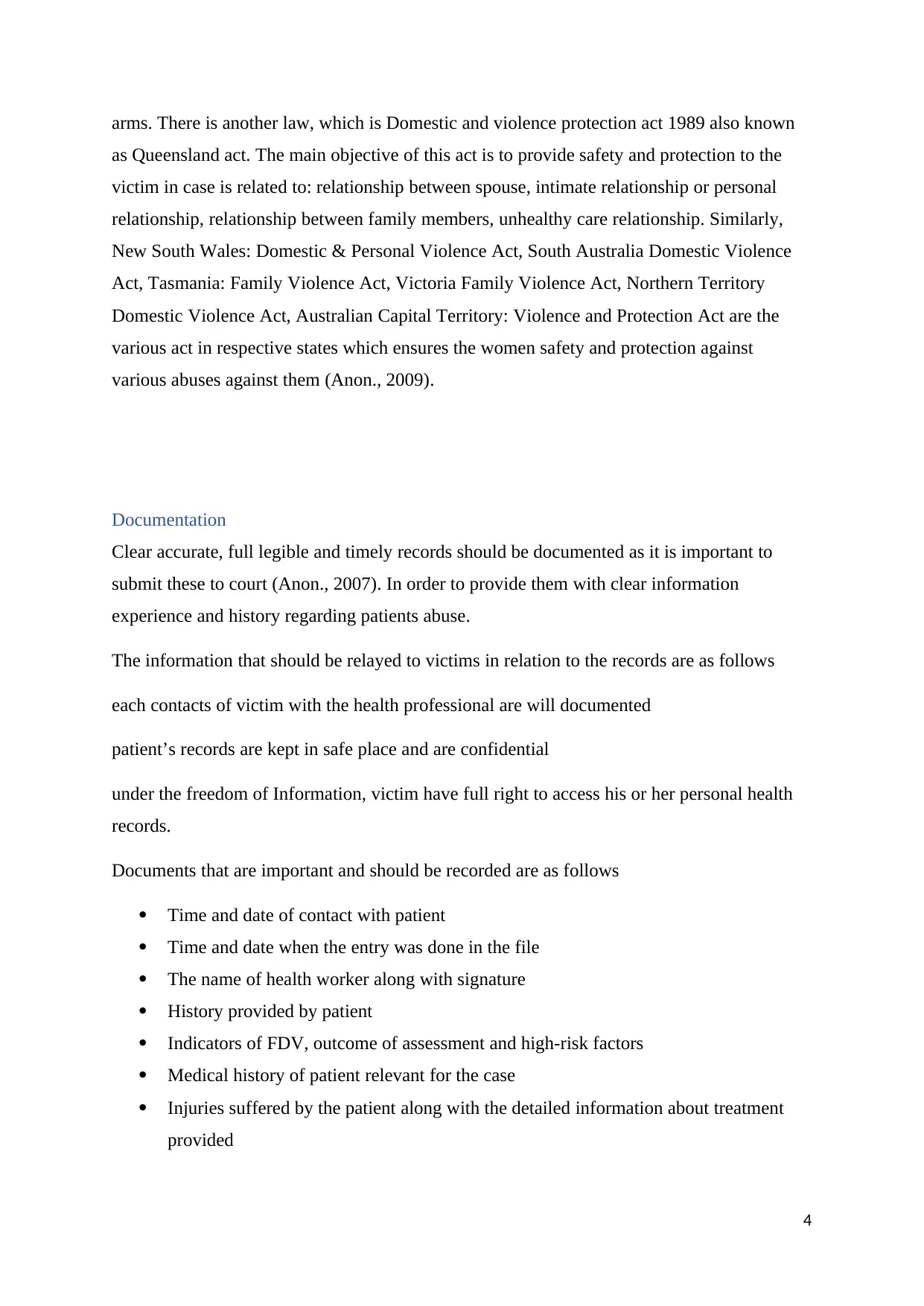
arms. There is another law, which is Domestic and violence protection act 1989 also known
as Queensland act. The main objective of this act is to provide safety and protection to the
victim in case is related to: relationship between spouse, intimate relationship or personal
relationship, relationship between family members, unhealthy care relationship. Similarly,
New South Wales: Domestic & Personal Violence Act, South Australia Domestic Violence
Act, Tasmania: Family Violence Act, Victoria Family Violence Act, Northern Territory
Domestic Violence Act, Australian Capital Territory: Violence and Protection Act are the
various act in respective states which ensures the women safety and protection against
various abuses against them (Anon., 2009).
Documentation
Clear accurate, full legible and timely records should be documented as it is important to
submit these to court (Anon., 2007). In order to provide them with clear information
experience and history regarding patients abuse.
The information that should be relayed to victims in relation to the records are as follows
each contacts of victim with the health professional are will documented
patient’s records are kept in safe place and are confidential
under the freedom of Information, victim have full right to access his or her personal health
records.
Documents that are important and should be recorded are as follows
Time and date of contact with patient
Time and date when the entry was done in the file
The name of health worker along with signature
History provided by patient
Indicators of FDV, outcome of assessment and high-risk factors
Medical history of patient relevant for the case
Injuries suffered by the patient along with the detailed information about treatment
provided
4
as Queensland act. The main objective of this act is to provide safety and protection to the
victim in case is related to: relationship between spouse, intimate relationship or personal
relationship, relationship between family members, unhealthy care relationship. Similarly,
New South Wales: Domestic & Personal Violence Act, South Australia Domestic Violence
Act, Tasmania: Family Violence Act, Victoria Family Violence Act, Northern Territory
Domestic Violence Act, Australian Capital Territory: Violence and Protection Act are the
various act in respective states which ensures the women safety and protection against
various abuses against them (Anon., 2009).
Documentation
Clear accurate, full legible and timely records should be documented as it is important to
submit these to court (Anon., 2007). In order to provide them with clear information
experience and history regarding patients abuse.
The information that should be relayed to victims in relation to the records are as follows
each contacts of victim with the health professional are will documented
patient’s records are kept in safe place and are confidential
under the freedom of Information, victim have full right to access his or her personal health
records.
Documents that are important and should be recorded are as follows
Time and date of contact with patient
Time and date when the entry was done in the file
The name of health worker along with signature
History provided by patient
Indicators of FDV, outcome of assessment and high-risk factors
Medical history of patient relevant for the case
Injuries suffered by the patient along with the detailed information about treatment
provided
4
Secure Best Marks with AI Grader
Need help grading? Try our AI Grader for instant feedback on your assignments.
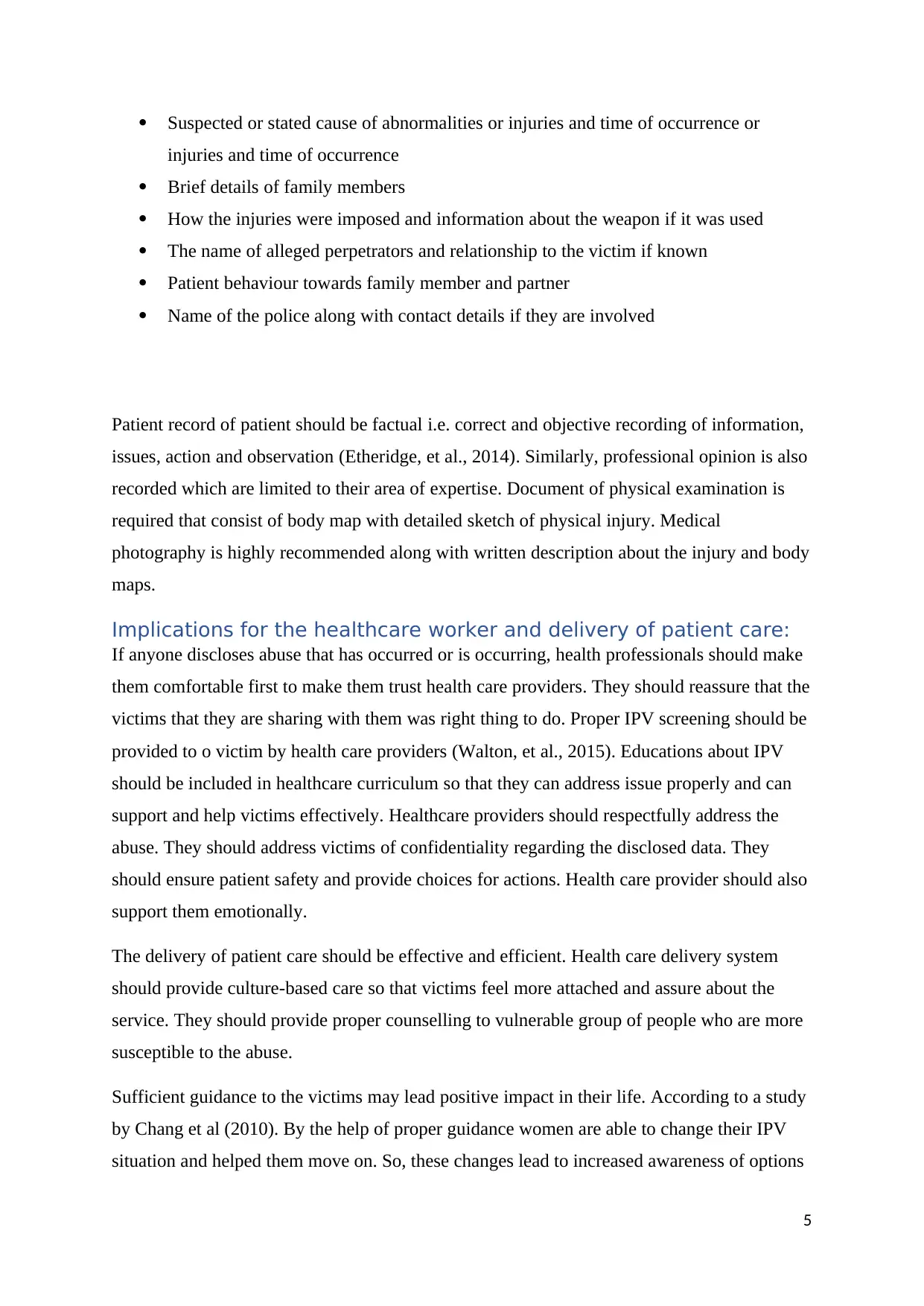
Suspected or stated cause of abnormalities or injuries and time of occurrence or
injuries and time of occurrence
Brief details of family members
How the injuries were imposed and information about the weapon if it was used
The name of alleged perpetrators and relationship to the victim if known
Patient behaviour towards family member and partner
Name of the police along with contact details if they are involved
Patient record of patient should be factual i.e. correct and objective recording of information,
issues, action and observation (Etheridge, et al., 2014). Similarly, professional opinion is also
recorded which are limited to their area of expertise. Document of physical examination is
required that consist of body map with detailed sketch of physical injury. Medical
photography is highly recommended along with written description about the injury and body
maps.
Implications for the healthcare worker and delivery of patient care:
If anyone discloses abuse that has occurred or is occurring, health professionals should make
them comfortable first to make them trust health care providers. They should reassure that the
victims that they are sharing with them was right thing to do. Proper IPV screening should be
provided to o victim by health care providers (Walton, et al., 2015). Educations about IPV
should be included in healthcare curriculum so that they can address issue properly and can
support and help victims effectively. Healthcare providers should respectfully address the
abuse. They should address victims of confidentiality regarding the disclosed data. They
should ensure patient safety and provide choices for actions. Health care provider should also
support them emotionally.
The delivery of patient care should be effective and efficient. Health care delivery system
should provide culture-based care so that victims feel more attached and assure about the
service. They should provide proper counselling to vulnerable group of people who are more
susceptible to the abuse.
Sufficient guidance to the victims may lead positive impact in their life. According to a study
by Chang et al (2010). By the help of proper guidance women are able to change their IPV
situation and helped them move on. So, these changes lead to increased awareness of options
5
injuries and time of occurrence
Brief details of family members
How the injuries were imposed and information about the weapon if it was used
The name of alleged perpetrators and relationship to the victim if known
Patient behaviour towards family member and partner
Name of the police along with contact details if they are involved
Patient record of patient should be factual i.e. correct and objective recording of information,
issues, action and observation (Etheridge, et al., 2014). Similarly, professional opinion is also
recorded which are limited to their area of expertise. Document of physical examination is
required that consist of body map with detailed sketch of physical injury. Medical
photography is highly recommended along with written description about the injury and body
maps.
Implications for the healthcare worker and delivery of patient care:
If anyone discloses abuse that has occurred or is occurring, health professionals should make
them comfortable first to make them trust health care providers. They should reassure that the
victims that they are sharing with them was right thing to do. Proper IPV screening should be
provided to o victim by health care providers (Walton, et al., 2015). Educations about IPV
should be included in healthcare curriculum so that they can address issue properly and can
support and help victims effectively. Healthcare providers should respectfully address the
abuse. They should address victims of confidentiality regarding the disclosed data. They
should ensure patient safety and provide choices for actions. Health care provider should also
support them emotionally.
The delivery of patient care should be effective and efficient. Health care delivery system
should provide culture-based care so that victims feel more attached and assure about the
service. They should provide proper counselling to vulnerable group of people who are more
susceptible to the abuse.
Sufficient guidance to the victims may lead positive impact in their life. According to a study
by Chang et al (2010). By the help of proper guidance women are able to change their IPV
situation and helped them move on. So, these changes lead to increased awareness of options
5
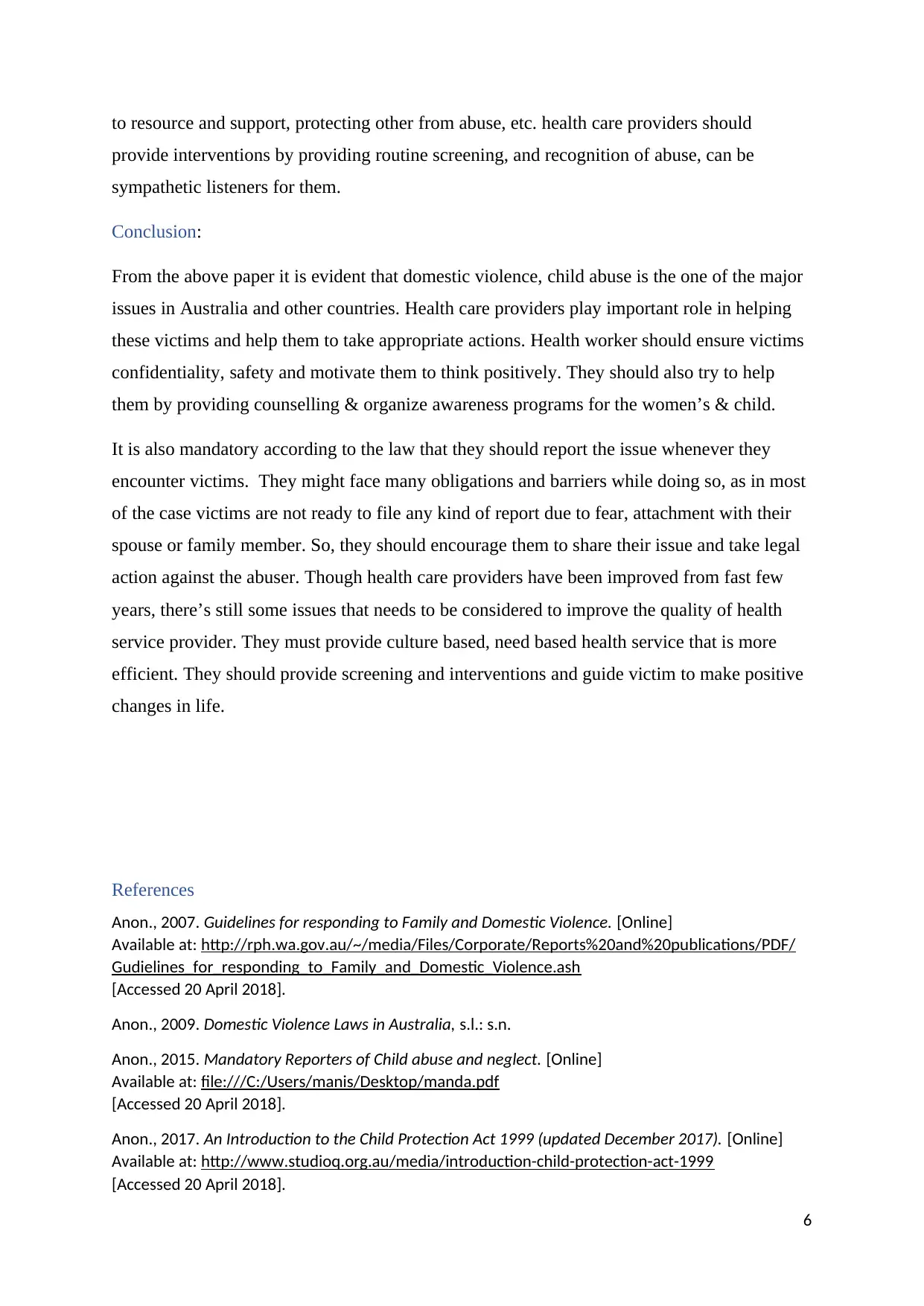
to resource and support, protecting other from abuse, etc. health care providers should
provide interventions by providing routine screening, and recognition of abuse, can be
sympathetic listeners for them.
Conclusion:
From the above paper it is evident that domestic violence, child abuse is the one of the major
issues in Australia and other countries. Health care providers play important role in helping
these victims and help them to take appropriate actions. Health worker should ensure victims
confidentiality, safety and motivate them to think positively. They should also try to help
them by providing counselling & organize awareness programs for the women’s & child.
It is also mandatory according to the law that they should report the issue whenever they
encounter victims. They might face many obligations and barriers while doing so, as in most
of the case victims are not ready to file any kind of report due to fear, attachment with their
spouse or family member. So, they should encourage them to share their issue and take legal
action against the abuser. Though health care providers have been improved from fast few
years, there’s still some issues that needs to be considered to improve the quality of health
service provider. They must provide culture based, need based health service that is more
efficient. They should provide screening and interventions and guide victim to make positive
changes in life.
References
Anon., 2007. Guidelines for responding to Family and Domestic Violence. [Online]
Available at: http://rph.wa.gov.au/~/media/Files/Corporate/Reports%20and%20publications/PDF/
Gudielines_for_responding_to_Family_and_Domestic_Violence.ash
[Accessed 20 April 2018].
Anon., 2009. Domestic Violence Laws in Australia, s.l.: s.n.
Anon., 2015. Mandatory Reporters of Child abuse and neglect. [Online]
Available at: file:///C:/Users/manis/Desktop/manda.pdf
[Accessed 20 April 2018].
Anon., 2017. An Introduction to the Child Protection Act 1999 (updated December 2017). [Online]
Available at: http://www.studioq.org.au/media/introduction-child-protection-act-1999
[Accessed 20 April 2018].
6
provide interventions by providing routine screening, and recognition of abuse, can be
sympathetic listeners for them.
Conclusion:
From the above paper it is evident that domestic violence, child abuse is the one of the major
issues in Australia and other countries. Health care providers play important role in helping
these victims and help them to take appropriate actions. Health worker should ensure victims
confidentiality, safety and motivate them to think positively. They should also try to help
them by providing counselling & organize awareness programs for the women’s & child.
It is also mandatory according to the law that they should report the issue whenever they
encounter victims. They might face many obligations and barriers while doing so, as in most
of the case victims are not ready to file any kind of report due to fear, attachment with their
spouse or family member. So, they should encourage them to share their issue and take legal
action against the abuser. Though health care providers have been improved from fast few
years, there’s still some issues that needs to be considered to improve the quality of health
service provider. They must provide culture based, need based health service that is more
efficient. They should provide screening and interventions and guide victim to make positive
changes in life.
References
Anon., 2007. Guidelines for responding to Family and Domestic Violence. [Online]
Available at: http://rph.wa.gov.au/~/media/Files/Corporate/Reports%20and%20publications/PDF/
Gudielines_for_responding_to_Family_and_Domestic_Violence.ash
[Accessed 20 April 2018].
Anon., 2009. Domestic Violence Laws in Australia, s.l.: s.n.
Anon., 2015. Mandatory Reporters of Child abuse and neglect. [Online]
Available at: file:///C:/Users/manis/Desktop/manda.pdf
[Accessed 20 April 2018].
Anon., 2017. An Introduction to the Child Protection Act 1999 (updated December 2017). [Online]
Available at: http://www.studioq.org.au/media/introduction-child-protection-act-1999
[Accessed 20 April 2018].
6

Anon., 2017. Queensland Child Protection Guide2017. [Online]
Available at: https://www.communities.qld.gov.au/childsafety/partners/our-government-partners/
queensland-child-protection-guide
[Accessed April 2018].
Anon., 2017. What is child abuse?. [Online]
Available at: https://www.communities.qld.gov.au/childsafety/protecting-children/what-child-abuse
[Accessed 21 April 2018].
Etheridge, A., Gill, L. & McDonald, J., 2014. Domestic Violence Toolkit for Health Care Providers in BC.
[Online]
Available at: https://www.kpu.ca/sites/default/files/NEVR/DV%20Toolkit%20%20PDF%20August
%2024.pdf
[Accessed 20 April 2018].
Phillips, J., 2009. Child abuse and protection in Australia. [Online]
Available at: https://www.aph.gov.au/About_Parliament/Parliamentary_Departments/
Parliamentary_Library/pubs/BN/0809/ChildAbuse
[Accessed 21 April 2018].
Schols, M. W., Ruiter, C. & Öry, F. G., 2013. How do public child healthcare professionals and primary
school teachers identify and handle child abuse cases? A qualitative study. NCBI, 13(807).
Walton, L. M. et al., 2015. Intimate Partner Violence Screening and Implications for Health Care
Providers. Online Journal of Health Ethics, 11(1).
7
Available at: https://www.communities.qld.gov.au/childsafety/partners/our-government-partners/
queensland-child-protection-guide
[Accessed April 2018].
Anon., 2017. What is child abuse?. [Online]
Available at: https://www.communities.qld.gov.au/childsafety/protecting-children/what-child-abuse
[Accessed 21 April 2018].
Etheridge, A., Gill, L. & McDonald, J., 2014. Domestic Violence Toolkit for Health Care Providers in BC.
[Online]
Available at: https://www.kpu.ca/sites/default/files/NEVR/DV%20Toolkit%20%20PDF%20August
%2024.pdf
[Accessed 20 April 2018].
Phillips, J., 2009. Child abuse and protection in Australia. [Online]
Available at: https://www.aph.gov.au/About_Parliament/Parliamentary_Departments/
Parliamentary_Library/pubs/BN/0809/ChildAbuse
[Accessed 21 April 2018].
Schols, M. W., Ruiter, C. & Öry, F. G., 2013. How do public child healthcare professionals and primary
school teachers identify and handle child abuse cases? A qualitative study. NCBI, 13(807).
Walton, L. M. et al., 2015. Intimate Partner Violence Screening and Implications for Health Care
Providers. Online Journal of Health Ethics, 11(1).
7
1 out of 7
Related Documents
Your All-in-One AI-Powered Toolkit for Academic Success.
+13062052269
info@desklib.com
Available 24*7 on WhatsApp / Email
![[object Object]](/_next/static/media/star-bottom.7253800d.svg)
Unlock your academic potential
© 2024 | Zucol Services PVT LTD | All rights reserved.





